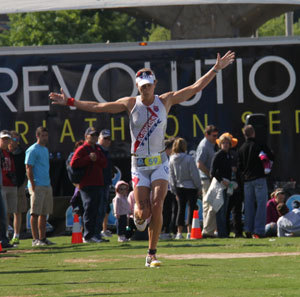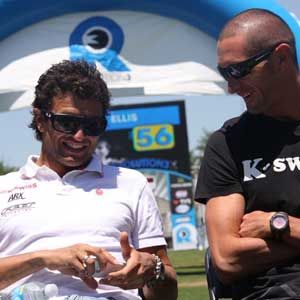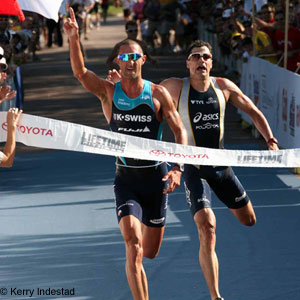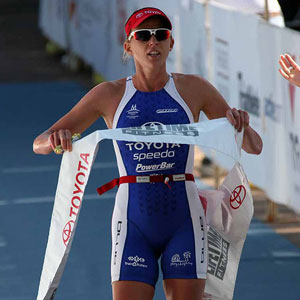The Rev3 Triathlon series

Right about the time when the U.S. and world financial markets were imploding and much of the world was riding out an economic storm, the business of triathlon series not the obvious route to riches. In 2008 and 2009 some well established series such as the Lifetime Fitness / Race to the Toyota Cup were reining in their groundbreaking large professional prize purses, and established mega-tri entities like the World Triathlon Corporation and the ITU purses were not increasing their payouts.
But a 30-year-old government contractor and amateur triathlete and adventure racer from northern Virginia decided to go against the conservative tide. In September of 2008, Charlie Patten and his newly formed Revolution3 group announced an ambitious half Ironman event to be held June 7, 2009 on a challenging, hilly course located at the Quassy amusement park in Middlebury, Connecticut.
The plan was to offer professional prize money that bettered the WTC’s Ironman 70.3 World Championship $90,000 pro purse by $10,000. In addition, Rev3 was also offering $20,000 in cash and prizes to the age group field.
The plan was to offer professional prize money that bettered the WTC’s Ironman 70.3 World Championship $90,000 pro purse by $10,000. In addition, Rev3 was also offering $20,000 in cash and prizes to the age group field.
Adding to the odds against its success was the challenge of choosing to start the race from scratch with a new venue with the hopes of drawing a world class field. After its start as a standalone, televised, big money event in Minneapolis—located on a longstanding traditional course—Lifetime Fitness eventually expanded to a series including established races in Los Angeles, Chicago and New York which already had large, revenue-generating age group fields. By contrast, the ambitious Tri 101 series which promised big pro purses for its three-quarters of an Ironman-distance events went belly up after two new races held in small new locations and canceled its final two scheduled events in 2007.

As extensive promotion, a big purse and some luck would have it, the first Rev3 race in Middlebury Connecticut drew four world champion women who provided an exciting duel won by Mirinda Carfrae. While the men’s field only had one world champion, Paul Amey, established star Matt Reed prevailed in a tight, 3-man finish.
While exciting high profile elite races may prime the pump for a new event, the long term success requires large age group fields. On that account, the inaugural Rev3 at Quassy had an acceptable-for-a-debut total of 550 finishers both because of and despite the race’s rep as one of the toughest half Ironman layouts in the world.
With more investment capital than the ill-fated Tri 101, a better pro field, greater age group numbers and better control over venues with the support of the Quassy amusement park where the race was held, Rev3 advanced to an expanded second season in 2010. The series started with a $50,000 purse — $7,000 each to the winners – for an Olympic distance race in Knoxville, Tennessee. The second year at Quassy featured an increased $150,000 prize purse — $20,000 for the winners — for Rev3’s premier half Ironman distance event. And the 2010 Rev3 season culminated with a $100,000 purse — $16,000 for the winners – for a full Ironman distance event centered at the Cedar Point amusement park in Sandusky, Ohio. To up the interest, Rev3 took a page from the 2007 Lifetime Fitness Series by posting a $125,000 bonus for any triathlete who could win all three events. That was in addition to a $15,000 prize for the men’s and women’s overall series winners.
The total prize purses in the three-race Rev3 series added up to $420,000 – almost precisely the amount offered by the downsized prize money offered by the Lifetime Fitness six-race series.
Primed by increasing prize money and the lure of the $125,000 bonus, the second year Rev3 fields were high quality and yielded several great duels. After winning Round One in Knoxville, Matt Reed and Julie Dibens went all out trying to preserve their chances at the $125,000 series slam bonus, but by the end of the day in Quassy, two world-class thoroughbreds — two-time Ironman World Champion and 2006 IM 70.3 world titlist Craig Alexander and Mirinda Carfrae – prevailed for the $20,000 wins.

Beyond the excitement of their 2010 races, Rev3 entries increased by a reassuring margin that buoyed long term hopes for survival and profits. Knoxville debuted with 366 Olympic distance finishers and 179 who completed the half for a one day total of 545 – equal to the 2009 Quassy debut. Helped by positive reviews for the first year race, Quassy drew 383 finishers for its Olympic race and 681 for the half distance event for a total of 1,064 finishers from an estimated 1,300 starters – doubling the 2009 totals. Cedar Point drew 339 to the full and 594 to the half for a total of 993 finishers.
He may be an enthusiastic age group athlete, but Rev3 CEO Charlie Patten is a businessman first. So he required bottom line indicators like the attendance jumps to afford the patience needed to bet that Rev3 is on the road to the black.
“We have a parent company that backs us and they understand that start ups take time to show profits,” he said. “Right now, we are looking at a 4-5 year plan for a return on the initial investment.”
The relative success of year 2 has inspired Rev3 to add races in Portland, Oregon ($50,000 prize purse), Anderson, South Carolina ($50,000 prize purse) and a combination Olympic distance triathlon ($30,000 prize purse) in Costa Rica, making Revolution 3 technically an international series.
Patten won’t reveal all the details of this private company, but is willing to give a few hints. “For more reasons then one, I would rather not get too deep into who the investors are behind Rev3. I am in investor in Rev3 as well as one corporate entity. Also, I would rather not get into what the investment is to date. I will go as far to say that it is a heavy front loaded investment. Our expenditures were very large for year one, a little less for year two, and we will follow that pattern for year three. It is our plan to hit the end of the runway and to have the wheels on the airplane up by year 5! That said, there are some things we are working on that may or may not help us reach the end of the runway by the start of year five.”
The moment that sparked Patten to dream up Rev3 came when he was waiting in line to sign up for Ironman Lake Placid after finishing the 2008 race in 12 hours 15 minutes. “The thought came into my mind while I was waiting in line,” said Patten. “The supply of quality races must be very low if athletes are dishing over $500 one year in advance. And people were securing their accommodations for the following year while they were checking out of their hotel on Monday after the race. What sealed the deal for me was the fact that a lot of those athletes were complaining about having to commit so far in advance.”

While Patten was also a fan of the many things that WTC does well, he shared the frustration many feel about the effort it takes to get into Ironman races and saw an opening. “We learned a ton about race production from Ironman and we try our hardest to replicate the things they do well,” he says. “That said, we also felt that a certain customer focus was lacking. When we decided to put on major triathlons, we made it our mission to truly try our hardest to put the customers first and understand our clients’ needs.”
One of those needs was to avoid the WTC’s hard line on refunds. “For example, if you serve in the military and end up with a deployment that you weren’t expecting, you better believe that at Rev3 we are refunding your money,” he said. “Get pregnant? ‘Congratulations, here’s your money back and we hope to see you in the future!’ Death in the family? ‘We are sorry for your loss; here is your money back.’” Obviously, we use discretion, but the point is that we care about the athlete.”
In launching his series, Patten also tried to think out of the box with technology and race coverage. Instead of paying out big money for broadcast television of Rev3’s debut 2009 event, he initiated live streaming internet race coverage with live video more like the ITU live internet coverage than the WTC’s no live video but extensive print and stats Ironman coverage. For the first event at Quassy they not only had live coverage on a Jumbotron screen at the start finish line, they also offered spectators access to computers in the transition area equipped with that Trakkers, a GPS technology that tracks athletes and offered real-time information such as location, speed, heart rate, elevation and current pace of the athletes.
After the first two seasons, Patten’s thinking on the technology front is evolving. “We started off the series with a big bang and a large focus on new technologies,” he said. “We found quickly that, while people appreciated the effort, they were ok with doing things in a more traditional way.”
For the past two years, he says, “all of our races had live Internet coverage. That goes along with our approach of using technology as a differentiator in the marketplace. We will scale that back a bit in the coming year so we can focus on a TV production. We will have live coverage of some sort, but we have yet to figure out what that means. We will in fact have a highlight reel available by the evening at each one of our races next year. We have pulled together a great team for our video productions. We will be using Upstage Video for a large piece of the production and have teamed up with Greg McFadden to help with producing and directing the live show.”
Live internet coverage done well, says Patten, “is awesome, but it doesn't bring in the same numbers of eyes that a TV production would bring in. From a sponsor’s perspective, especially one that is not in the triathlon industry, TV is more valuable to them. We were getting anywhere from 60,000 to 100,000 of viewers for our Internet coverage. But TV may bring us in the millions and we are looking into a production or multiple TV productions for 2011.”
Patten is willing to take risks and favors thinking outside the box, so does he come break the mold of the current race director and CEO. When he started Revolution3, he was not yet 30—younger than many of the marquee pros and far younger than the average race directors and impresarios that rule the business of triathlon.
“Truth of the matter is, I am getting old. I went over the hill in 2009 when I had my 30th birthday.”
He was born in Hartford, Connecticut, and spent his childhood moving around the country from army base to army base. He graduated from high school in 1998, spent his summer mowing greens at a golf course and shipped out for Army National Guard boot camp in September of that same year. “The day my father retired, he swore me into the Army National Guard,” recalled Patten. “Seeing as I am not that smart and lack an inner drive to produce a quality report on economics, I bypassed the whole college thing. I spent 7 years in the Army National Guard and have been in the world of government contracting ever since.”
He started in triathlons in 2007 and finished IM Lake Placid in 2008. “I signed up for Lake Placid again this coming July,” he said, “but the 40 extra pounds I put on since starting Rev3 is making that look more daunting! Guess it's time to start training again.”



